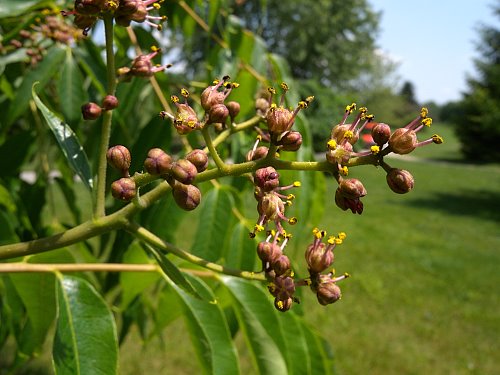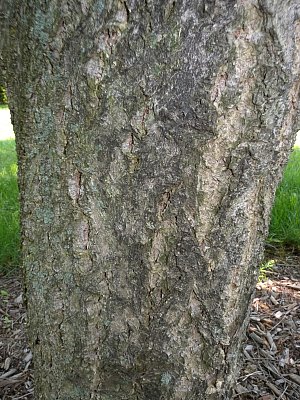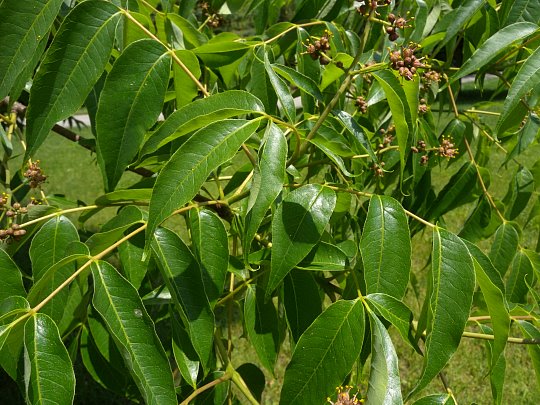
Small clusters of flowers about 2-4" long develop among the leaves. Amur Corktree is dioecious, producing either all male (staminate) or all female (pistillate) flowers on separate trees. Regardless of gender, individual flowers are about 1/8" (3 mm.) across, consisting of a short green or maroon calyx with 5 teeth and a yellowish green or maroon corolla with 5 lobes. Each female flower has a pistil, while each male flower has 5 exerted stamens with bright yellow anthers. The branches of the inflorescence are light green to yellowish green and either glabrous or pubescent. The blooming period occurs from late spring to early summer for about two weeks. Afterwards, the female flowers are replaced by small globoid fruits spanning about 3/8" (1 cm.) across; these fruits are initially green, then they become off-white, and finally blue-black or black when they are mature during the autumn. Each fruit contains 5 seeds. The odor of the fruits is similar to the odor of the crushed foliage (see above). The root system spreads widely. The deciduous leaves turn yellow during the autumn.
Cultivation: The preference is full to partial sun, moist but well-drained conditions, and fertile loam or silty loam. However, young trees and saplings can tolerate considerable shade. Individual trees can produce flowers and fruits in as little as 5 years.

Range & Habitat: The introduced Amur Corktree has rarely escaped from cultivation in Illinois, although naturalized trees have been reported from Dupage County in the NE section of the state (see Distribution Map). Amur Corktree is native to northern China, Korea, and Japan, and it was introduced into North America as a landscape tree. Habitats of naturalized trees consist of areas in or near parks and open disturbed areas in urban and suburban settings. This tree is occasionally cultivated (consisting primarily of male cultivars), and it is considered invasive in some areas of northeastern United States. As an invasive species, Amur Corktree can dominate a wooded area by forming a dense mass of young trees that shade out other plants.
Faunal Associations: Information about insect pollinators of the flowers is unavailable for this tree. The caterpillars of a small number of moths that are found in eastern North America are known to feed on the foliage: Biston betularia (Pepper & Salt Geometer), Hyphantria cunea (Fall Webworm Moth), and Samia cynthia (Ailanthus Silkworm Moth). The fruits are spread to new areas by the Robin (Turdus migratorius) and other birds. The relatively dense crown of this tree probably provides cover and nesting habitat for some birds.
Photographic Location: The Toledo Botanical Garden in Toledo, Ohio. The photographed tree is a male cultivar.

Comments: The most distinctive characteristic of this tree is the corky inner bark; it is relatively soft and bright yellow. The compound leaves are quite attractive, in part because they are rarely marred by insects and disease. When the flowers of this tree are maroon, rather than yellowish green, they stand out from the background better, creating a more attractive display. Amur Corktree is the only species of its genus that has naturalized in Illinois, making it fairly distinct from other trees. While some trees within the state have alternate pinnate leaves, Amur Corktree has opposite pinnate leaves and the petiole-scars of its twigs are U-shaped. Later in the year, it produces dark berries that are dispersed by birds, rather than winged seeds that are dispersed by the wind.